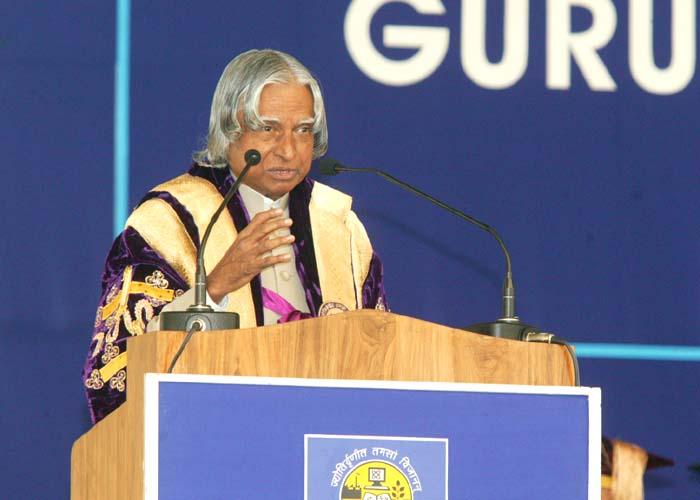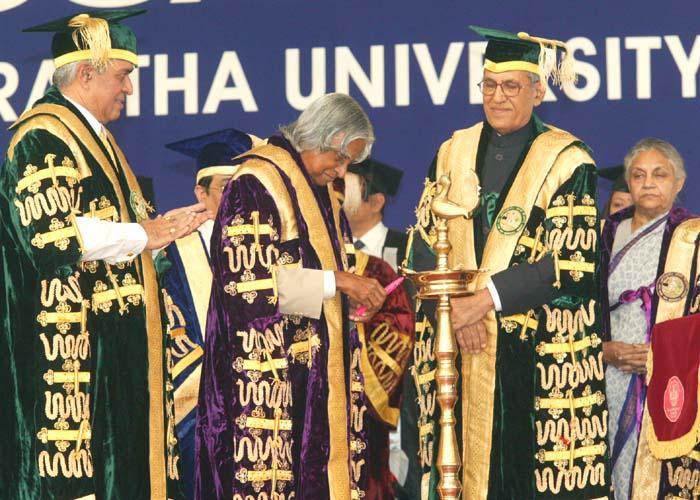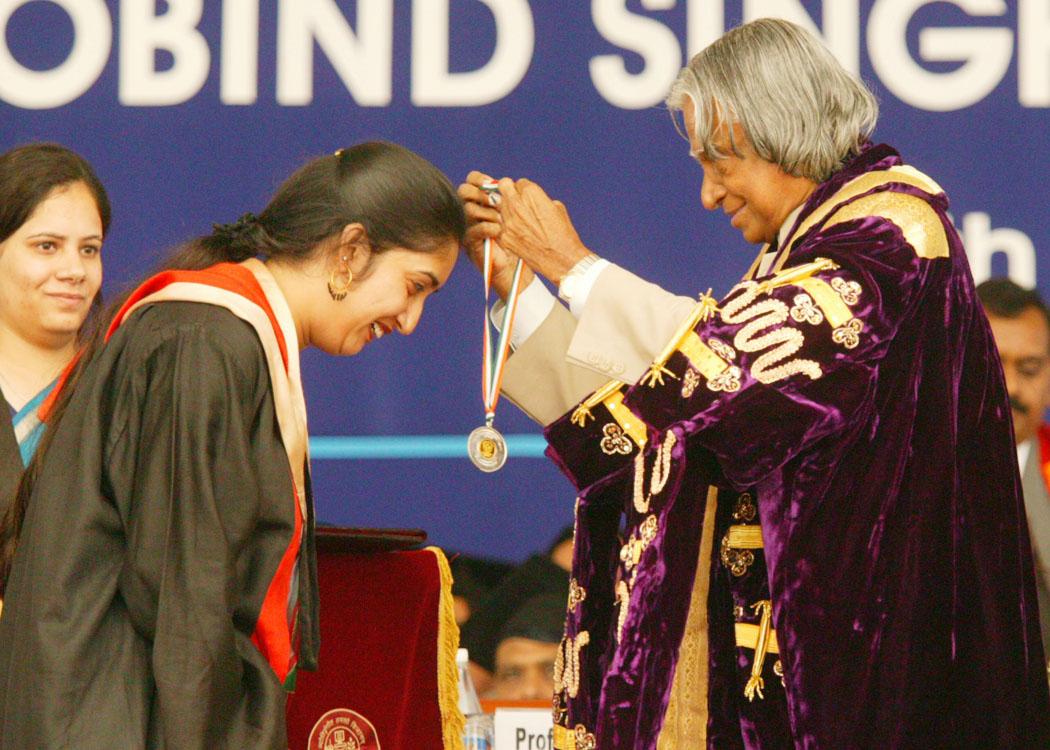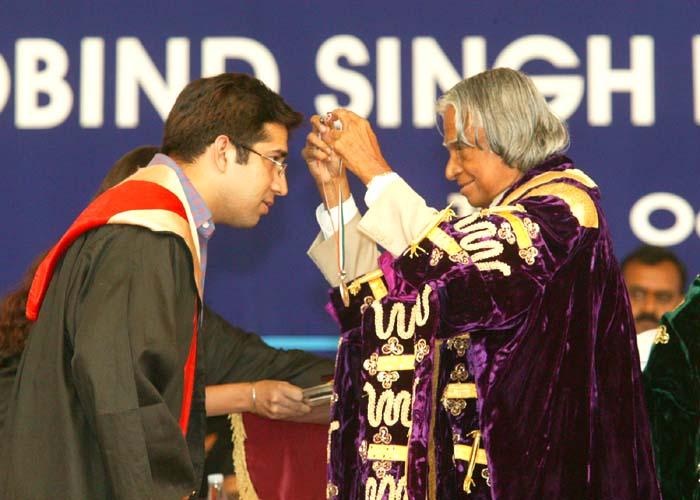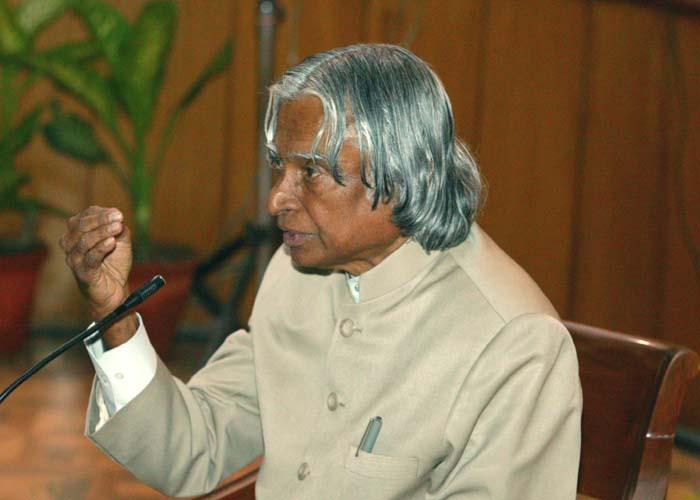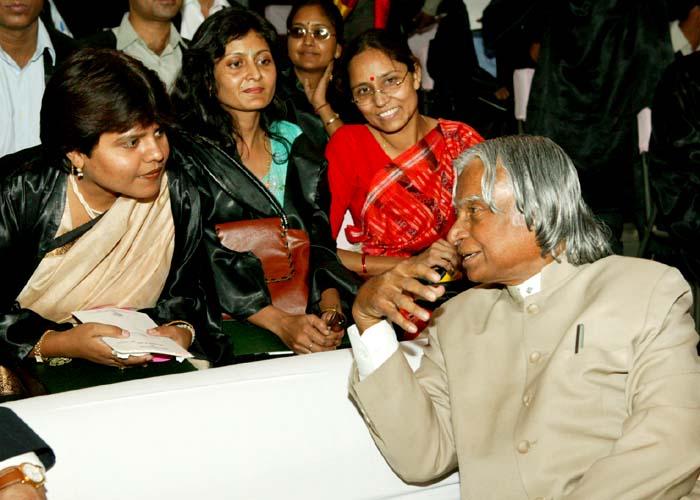Address At The First Convocation Of Guru Gobind Singh Indraprastha University
New Delhi : 19-10-2004
Creative Leaders for National Development
I am indeed delighted to participate in the First Convocation of Guru Gobind Singh Indraprastha University. I take this opportunity to congratulate the University students for their excellent academic performance. I greet the Chancellor, Vice-Chancellor, Professors, teachers and staff for shaping the young minds and preparing them to contribute to the nation in multiple fields. Dear graduates, when you complete your education in this University, the learning and in turn the empowerment will certainly assist you to meet the challenges in life. My best wishes.
University Core Competence
The University is mainly concentrating on professional courses such as engineering & technology, medical, bio-technology, physiotherapy, nursing, education, law, business management, hotel management, mass communication etc. Also, I am happy to note that the University has a single window admission form which can be downloaded from the net and submitted electronically and the fees also can be paid through the net. I understand that some of the affiliated colleges are working towards qualifying their institute towards ISO certification. This is definitely a progressive step for promoting excellence in education.
Evolution of enriched societies
Friends, the developing countries always have a mindset to follow step-by-step the footsteps of the developed countries, in the developmental process. This I call it a beaten track. The reason is, there are multiple societies in every nation starting from agricultural society, industrial society, and information society leading to the knowledge society in the 21st century. These societies underwent a transformation from the agricultural society, where manual labour was the critical factor to the industrial society, where the management of technology, capital, and labour provided the competitive advantage. The information era in the last decade, saw networking within the country and with the other nations and the software products drove the economies. Some of the nations including India used this opportunity well and could demonstrate its core competence in IT. The entry to knowledge society has given India a great opportunity to bring back the glory of our nation again.
The uniqueness of knowledge society is enriching the information society with innovation and value addition of products. The knowledge also enables value addition to the other three societies. In knowledge society, knowledge is the primary production resource instead of capital or labour. In India, I happened to chair the task team in the 90?s constituted by the Government of India for drawing a road map for transforming the Indian society into a knowledge society, skipping the beaten track. I would like to discuss with you how we can work together to make our societies enriched by knowledge and transforming them into knowledge society.
Efficient utilization of existing knowledge can create a comprehensive wealth for the nation and also improve the quality of life, in the form of better health, education, infrastructure, and other societal needs. The ability to create and maintain a knowledge society infrastructure, develop the knowledge workers, and enhance their productivity through the creation, growth, and exploitation of new knowledge, will be the key factor in deciding the prosperity of this knowledge society. Whether or not a nation has developed into a knowledge society is judged by the way it creates and deploys knowledge in the sectors like ICT, Manufacturing, Agriculture, and Healthcare and so on in order to create wealth for the society, business and the people. Knowledge and wealth creation have to go hand in hand in a knowledge society.
Dimensions of Knowledge Society
I was studying different dimensions of knowledge society and how will it be different from the industrial economy. In the knowledge economy the objective of a society changes from fulfilling the basic needs of all round development to empowerment. The education system instead of going by text book teaching will be promoted by creative, interactive self learning ? formal and informal with focus on values, merit and quality. The workers instead of being skilled or semi-skilled will be knowledgeable, self-empowered and flexibly skilled and would adapt to newer technologies seamlessly. The type of work instead of being structured and hardware driven will be less structured and software driven. Management style will emphasize more on delegation rather than giving command. Impact on environment and ecology will be strikingly less compared to the industrial economy.
Finally, the economy will be knowledge driven and not industry driven for which special capacities need to be built and nurtured among the students. Many of them have to be an employment generator that is entrepreneurs instead of mere employees in Government or big industries. I will be highlighting five unique capacities to be built during the learning period of the students.
Capacity Building Model
When the students come out of the University certain capacities are required to be built in them for enabling them to face the challenges in the real world, in their professional career and also facilitate their participation in the task of national development. I suggest that the ingredients for capacity building must be embedded right from the beginning of the students? life. A good educational model is the need of the hour to ensure that the students grow to contribute towards the economic growth of a nation. I am sure that the University is paying attention to this need.
For participating in the nation building tasks, the capacities required to be built among the students in their formative years by the educational institutions are: The capacity for research or inquiry, the capacity for Creativity and Innovation, particularly the creative transfer of knowledge, the capacity to use high technology, the capacity for Entrepreneurial Leadership and the capacity for Moral Leadership.
a. Research and enquiry: The 21st century is about the management of all the knowledge and information we have generated and the value addition we bring to it. We must give our students the skills with which they find a way through the sea of knowledge that we have created and continue with life long learning. Today, we have the ability, through technology, to really and truly teach ourselves to become the life-long learners. This is required for sustained economic development, material and individual prosperity.
b. Creativity and innovation: The management of knowledge in the 21st century is beyond the capacity of a single individual. The amount of information that we have around is overwhelming. The management of knowledge therefore must move out of the realm of the individual and shift into the realm of the networked groups. The students must learn how to manage knowledge collectively and to work in multi-disciplinary teams. When the information is networked the power and utility of the information grows as squared as predicted by Metcalfe's law. An information that is static does not grow. In the new digital economy information that is circulated creates innovation and contributes to national wealth.
c. Capacity to use high technology: Every student in our schools should learn to know how to use the latest technologies for aiding their learning process. Universities should equip themselves with adequate computing equipment, laboratory equipments, and Internet facilities and provide an environment for the students to enhance their learning ability. In the midst of all of the technological innovations and revolutions we cannot think that the role of the teachers will be diminished. In fact the teacher will become even more important and the whole world of education will become teacher assisted and would help in ?tele-porting? the best teacher to every nook and corner of the country and propagate the knowledge. The teacher becomes a facilitator and knowledge manager.
d. Entrepreneurship: The aptitude for entrepreneurship should be cultivated right from the beginning and in the university environment. We must teach our students to take calculated risks for the sake of larger gain, but within the ethos of good business. They should also cultivate a disposition to do things right. This capacity will enable them to take up challenging tasks later.
e. Moral leadership: Moral leadership involves two aspects. First it requires the ability to have compelling and powerful dreams or visions of human betterment. Moral leadership requires a disposition to do the right thing and influence others also to do right things.
In sum, inquiry, creativity, technology, entrepreneurial and moral leadership are the five capacities required to be built through the education process. If we develop in all our students these five capacities, we will produce "Autonomous Learner" a self-directed, self controlled, lifelong learner who will have the capacity to both, respect authority and at the same time is capable of questioning authority, in an appropriate manner. These are the leaders who would work together as a "Self-organizing Network" and transform any nation into a developed nation in a time bound manner. The question which arises always in our mind is whether 'can we do'? Now I would like to discuss with you our experiences in mission mode projects.
Our experiences in Mission mode
During 1960's, I remember that India was in a ship to mouth existence for food grains. If the American ships do not bring wheat, there will be a famine in India. But there were two visionaries who worked together with the farming community and brought the first green revolution. They are the political thinker Shri. C. Subramaniam, the Agriculture scientist Dr. M.S. Swaminathan and Dr Kurien the master mind behind the white revolution. Today we produce two hundred million tonnes of food grains, which is not only sufficient for us but we can also export some quantity.
In India much innovation and creative thinking took place at various phases of our development. Dr. Vikram Sarabhai in 1960's said that India should design and develop large satellite launch vehicle and put communication satellite and remote sensing satellite in geo-synchronous orbit and polar orbit respectively. This vision statement ignited hundreds of scientist, technologists and thousands of technicians. Today India is capable of building any type of satellite launch vehicles and satellites. Similarly the Vision of nuclear programme led to establishing series of nuclear power plants adding 3000 megawatt power to our electrical grid of 100,000 megawatt.
In 1980's, India had a very low base in Information Technology. Some young entrepreneurs with their innovative and creative thoughts, within the difficult boundary conditions of India's rules and regulations, showed how IT enabled services can fetch export revenue. Subsequently, even Govt. had to bring out innovative and liberalized IT policies. Now, our young IT entrepreneurs are making export revenue of 15 billion dollars. Similarly the Pharma industries are making a positive impact in the India economy. Our garment industry, our export of flowers and diamond are not far behind.
I would like to discuss some of the major missions which are essential for transforming India into a developed nation they are: Providing Urban Amenities in Rural Areas (PURA) and Universal Tele-education which will lead to provision knowledge connectivity and Employment generation through entrepreneurship. I am sure that the brilliant minds who are graduating today would become partners in these missions and transform our country into a developed nation. In future these missions need not be driven by a Government department as was done by Space and Atomic Energy. It can be done by a bright group of entrepreneurs, using modern business models.
PURA (Providing Urban Amenities in Rural Areas)
a. Rural Prosperity through Connectivity: Nearly 700 million people of India live in the rural areas in 600,000 villages. Connectivity of village complexes providing economic opportunities to all segments of people is an urgent need to bridge the rural-urban divide, generate employment and enhance rural prosperity. The essential needs of the villages today are water, power, road, sanitation, and healthcare, education and employment generation.
b. Essential Connectivities through PURA: The integrated methods, which will bring prosperity to rural India are: the physical connectivity of the village clusters through quality roads and transport; electronic connectivity through tele-communication with high bandwidth fiber optic cables reaching the rural areas from urban cities and through internet kiosks; knowledge connectivity through education, vocational training for farmers, artisans and craftsmen and entrepreneurship programmes; these three connectivities will lead to economic connectivity through starting of enterprises with the help of banks, micro credits and marketing the products.
Universal Tele-Education
Now with the successful launch of Educational Satellite (EDUSAT) on 20th September 2004, it is possible to work on a viable distance education programme for many parts of the nation. A three-pronged approach is essential to make distance education programme viable and a successful proposition through the universal tele-education system to all remote parts of the country. The three components may be the Connectivity, Tele-Education System and the Quality Content Generation and deployment.
a. Connectivity: EDUSAT is expected to provide one-lakh fifty thousand ground terminals in its full capacity. The other parts of the country have to be covered by providing Broadband and Wireless communication network in an integrated fashion. Terrestrial optical communication is becoming cost effective and can complement the space communication with its low cost, high bandwidth and networking capability. An integrated networked system comprising EDUSAT, Broadband and Wireless networks should provide a highway for reaching quality education to all parts of the country.
b. Tele-Education System: Once we have the connectivity, then there should be a universal tele-education system in place for making full utilization of the connectivity to bring virtual classrooms in a multi class environment with seamless two-way interaction between the teachers and students in a collaborative environment. This system should not only enable the lecture delivered from the Studio at the university to reach any remote corner but also enable a good teacher in the remote area to provide multicast information to other participants of the programme.
c. A Tele-Education delivery system: I would like to narrate our experience in tele-education piloted at Rashtrapati Bhavan for providing satellite connectivity for the PREVIK (President?s Virtual Institute for Knowledge) members. The connectivity is through V-SATs provided by ISRO, Voice Over-IP and Internet. In this platform, the live virtual studio environment is created and it will connect a number of remote locations and provides seamless, one to many connectivity, through multicasting mode in a collaborative environment. This also provides two-way connectivity. In this platform, I can give a presentation and address the remote locations, where the multimedia delivery is possible and also I can interact through various collaborative tools. I can refer any informational website from Internet to all the remote locations and can also delegate the remote expert to give a lecture to all those who are connected. We have also established the Digital Library and digitized around two million pages. I can search for a particular page and push the page to all the participants through this tele-education. It is an integrated solution, which makes me feel as if I am virtually connected to all participants in multiple locations. In the present context with respect to universities, EDUSAT provides the connectivity. An integrated Tele-education delivery mechanism is available and being used. What is required now is the generation of quality content for sharing and transmitting to remote students.
d. Quality Content Generation: There are three components for education: lectures, laboratory and library. The content includes all the above three. Content can be generated in many ways. The first one is the assimilation of the subject by an expert teacher through research study of many books and articles leading to the generation of quality and creative content in a presentable format. The teacher presents in a unique and innovative way to make the content appealing and easily understandable to the students. The second form of content could be on a self-learning method by breaking down the content into a series of question answer models. Third may be from various books, which can be extracted through a digital library and presented just-in time to all the remote students.
e. Content Generation through Students: The content should have supportive animations, which may even bring virtual laboratories and virtual immersion effects to the remote students. When the content is generated, it should be a sharable learning object across the nation and across all platforms. Some institutions and universities have already started developing their content. The content may be generated making use of the student's creative and innovative thoughts under the guidance of the expert teachers as a group activity based on a pre-determined standard. This is possible where the capacity has been built by the educational institution into the student to teach while studying. The generated content through this process may be validated and deployed for delivery of lectures through tele-education system.
f. Enriching the Content: As an example, my lectures delivered during various functions are dynamically updated in our website. During the address many participants may ask questions on several topics. The answers to these questions are also placed in the website as supplementary information. Similarly, the teachers after delivering the talk will also be asked a number of questions by the students. The proceedings of the questions & answers session can be added to the content document for enriching it.
These two missions viz. PURA and Universal Tele-education will generate large scale employment opportunities for our youth, especially the graduates and post-graduates completing their education from Guru Gobind Singh Indraprastha University. Moreover, it will give a focus to the individual's contribution to the society and the Nation.
Employment Generation through Entrepreneurship
I understand that nearly five thousand students are graduating from this University this year and very soon this number is likely to reach ten thousand marks. I am informed that the placement has already taken place for more than 80% of the students in respect of engineering & technology and education courses. In other professional courses the placement ranges from 50 to 60%. For enabling appropriate employment for the remaining students it is essential for the University to create entrepreneurship courses. The provision of entrepreneurial training will enable the students to create enterprises thus becoming employment providers rather than becoming employment seekers. For students with entrepreneurial aptitude the University should facilitate provision of bank loans as venture capital without the students having to go through the process of ?tangible asset syndrome?. Also, the University can introduce the prospective entrepreneurs to the industrialists who can select the candidates as is done in the placement process.
Conclusion: Creative Leadership
There are 540 million youth below 25 years in the population of a billion people. The nation needs young leaders who can command the change for transformation of India into a developed nation embedded with knowledge society. The leaders are the creators of new organizations of excellence. Quality leaders are like magnets that will attract the best of persons to build the team for the organization and give inspiring leadership even during failures of missions as they are not afraid of risks. I have seen and worked with creators of vision and missions.
One of the very important ingredients for success of the vision of transforming India into a developed nation by 2020 is the evolution of creative leaders. I am giving a connectivity between developed India, economic prosperity, technology, production, productivity, employee role and management quality, all of which linked to the creative leader. Who is that creative leader? What are the qualities of a creative leader? The creative leadership is exercising the task to change the traditional role from commander to coach, manager to mentor, from director to delegator and from one who demands respect to one who facilitates self respect. The higher the proportion of creative leaders in a nation, the higher the potential of success of visions like "developed India."
Mission of Guru Gobind Singh Indraprastha University is to build capability of creative leadership among students which will generate many young entrepreneurs for participating in the transformation of India into a prosperous, happy and strong nation. I wish all the graduates a very bright future.
May God bless you.

